|
|

Product Numbers: POSIP-OC3-20-SM=, POSIP-OC3-20-MM=, POSIP-OC3-40-SM(=), POSIP-OC3-40-MM(=), and MEM-POSIP-64MB=
This publication contains instructions for installing and configuring the Packet OC-3 Interface Processor (POSIP), which is a fixed-configuration interface processor that uses second-generation Versatile Interface Processor (VIP2) technology. The POSIP complies with the Packet-Over-SONET specification.
This publication contains basic configuration steps and examples and includes the procedures for upgrading memory on the POSIP. The POSIP is compatible with any Cisco 7500 series router or any Cisco 7000 series router that is using a Route Switch Processor-based system processor card.
Sections in this publication include the following:
The Cisco IOS software running your router contains extensive features and functionality. For information on Cisco IOS software and for general installation and maintenance information for your router, use the following resources:
The following are common POSIP terms and acronyms for your reference:
Point-to-Point Protocol (PPP) was designed as a standard method of communicating over point- to-point links. Initial deployment has been over short local lines, leased lines, and plain-old-telephone-service (POTS) (also called basic telephone service) using modems. As new packet services and higher speed lines are introduced, PPP is easily deployed in these environments as well. PPP treats SONET/SDH transport as octet-oriented synchronous links. SONET/SDH links are full duplex by definition. PPP presents an octet interface to the physical layer. There is no provision for suboctets to be supplied or accepted.
The Synchronous Optical Network (SONET) is an octet-synchronous multiplex scheme that defines a family of standard rates and formats. Despite the name, it is not limited to optical links. Electrical specifications have been defined for single-mode fiber, multimode fiber, and CATV 75 ohm coaxial cable; however, the POSIP currently allows only transmission over single-mode and multimode optical fiber. The transmission rates are integral multiples of 51.840 megabits per second (Mbps), which may be used to carry T3/E3 bit-synchronous signals.
The following transmission multiples are currently specified and commonly used, and are expressed in terms of Mbps:
The ITU-T defines a series of SDH transmission rates beginning at 155.520 Mbps, as follows:
| SONET1 | SDH equivalent |
|---|---|
STS-3c2 | STM-12 |
STS-12c | STM-4c |
STS-48c | STM-16c |
| 1ANSI-defined SONET specifications. 2Currently supported by the POSIP. |
The Packet-Over-SONET specification is primarily concerned with the use of the PPP encapsulation over SONET/SDH links. Since SONET/SDH is by definition a point-to-point circuit, PPP is well suited for use over these links. The octet stream is mapped into the SONET/SDH Synchronous Payload Envelope (SPE), with the octet boundaries aligned with the SPE octet boundaries. The PPP frames are located by row within the SPE payload. Because frames are variable in length, the frames are allowed to cross SPE boundaries.
The basic rate for Packet-Over-SONET is that of STS-3c/STM-1, which is 155.520 Mbps. The available information bandwidth is 149.760 Mbps, which is the STS-3c/STM-1 SPE with section, line, and path overhead removed.
The following references discuss concepts and specifications of Packet-Over-SONET and PPP:
This section provides a description of the POSIP. The POSIP (see Figure 1 and Figure 2) provides a single 155.520-Mbps, Packet OC-3 network interface for Cisco 7000 series and 7500 series routers.
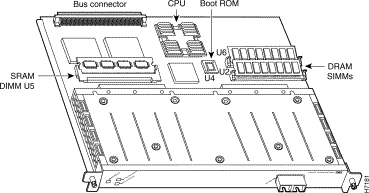

Packet data is transported using Point-to-Point Protocol (PPP) and is mapped into the STS-3c/STM-1 frame. The Packet OC-3 interface is compliant with RFC 1619, "PPP over SONET/SDH," and RFC 1662, "PPP in HDLC-like Framing." The encapsulations used add approximately half of the number of bytes of transport overhead as that involved with ATM using ATM adaptation layer 5 (AAL5) and line card control (LCC) Subnetwork Access Protocol (SNAP) encapsulations.
 | Caution The POSIP is made up of two main parts: a dual-width port adapter and a motherboard. To prevent problems with the POSIP and with the system in which the POSIP is installed, do not attempt to separate the POSIP's port adapter from its motherboard or to install other port adapters on the POSIP motherboard. The entire POSIP assembly is a field replaceable unit (FRU). |
The POSIP comes configured with either 16 MB or 32 MB of dynamic random-access memory (DRAM) and 1 or 2 MB of static random-access memory (SRAM) as the factory default memory configurations. The DRAM and SRAM on the POSIP-OC3-20 models can be upgraded as your system configuration requires. (For DRAM and SRAM upgrade procedures, refer to the section "Upgrading POSIP DRAM and SRAM" on page 38.)
The network interfaces reside on the POSIP and provide a direct connection between the high-speed Cisco Extended Bus (CxBus or CyBus) and the external networks. The physical layer interface on the POSIP is OC-3. There are no restrictions on slot locations or sequence; you can install a POSIP in any available interface processor slot.
 | Caution Traffic from multiple POSIP network interfaces could theoretically exceed the bandwidth of the CxBus or CyBus. This would cause packets to be dropped; therefore, a practical limit for the CxBus in Cisco 7000 series chassis is two POSIPs, and for the CyBus in Cisco 7500 series chassis the practical limit is four POSIPs. |
The POSIP supports the following features:
Following are the POSIP DRAM and SRAM configurations by product number, memory configuration, and optical-fiber connections:
If you purchased a pre-POSIP product (Product Numbers Pre-POSIP-20-SM=, Pre-POSIP-20-MM=, Pre-POSIP-40-SM=, or Pre-POSIP-40-MM=), refer to Table 1, which lists the POSIP upgrade products that are available and the pre-POSIP products they replace.
| POSIP Upgrade Product1 | Upgrades from... | To... |
|---|---|---|
Pre-POS20sm-UPG | Pre-POSIP-20-SM= | POSIP-OC3-20-SM= |
Pre-POS40sm-UPG | Pre-POSIP-40-SM= | POSIP-OC3-40-SM= |
Pre-POS20mm-UPG | Pre-POSIP-20-MM= | POSIP-OC3-20-MM= |
Pre-POS40mm-UPG | Pre-POSIP-40-MM= | POSIP-OC3-40-MM |
| 1Shipped only to users who have the pre-POSIP products listed in the second column. |
Following is the protocol and management information base (MIB) support for the POSIP:
The following encapsulation method is supported by the POSIP: RFC 1619 Point-to-Point Protocol over SONET/SDH.
The Packet OC-3 interface is full duplex. You must use the appropriate optical-fiber interface cable(s) to connect the POSIP with an external network. Refer to the section "POSIP Interface Cables" on page 12 for descriptions of connectors and optical-fiber cables. The POSIP, shown in Figure 1, provides an interface to switching fabrics for transmitting and receiving data at rates of up to 155.520 Mbps bidirectionally. The POSIP connects to the following physical layers:
The Packet-Over-SONET specification for optical-fiber transmission defines two types of fiber: single mode and multimode. Modes can be thought of as bundles of light rays entering the fiber at a particular angle. Single-mode fiber allows only one mode of light to propagate through the fiber, while multimode fiber allows multiple modes of light to propagate through the fiber. Because multiple modes of light propagating through the fiber travel different distances depending on the entry angles, causing them to arrive at the destination at different times (a phenomenon called modal dispersion), single-mode fiber is capable of higher bandwidth and greater cable run distances than multimode fiber. Table 2 lists typical maximum distances for single-mode and multimode transmission.
| Transceiver Type | Power Budget | Transmit Power | Receive Power | Maximum Distance between Stations1 |
|---|---|---|---|---|
Single mode2 | 16 dB | -15 to -8 dBm, | -31 to -8 dBm | Up to 9 miles (15 kilometers) |
Multimode2 | 11.5 dB | -18.5 to -14 dBm, | -30 to -14 dBm | Up to 1.5 miles (3 kilometers) |
| 1Table 2 gives typical results. You should use the power budget calculations to determine the actual distances. 2Complies with Bellcore GR-253 Intermediate Reach Specification. 3Where nm = nanometers. |
To design an efficient optical data link, evaluate the power budget. The power budget is the amount of light available to overcome attenuation in the optical link and to exceed the minimum power that the receiver requires to operate within its specifications. Proper operation of an optical data link depends on modulated light reaching the receiver with enough power to be correctly demodulated. Attenuation, caused by the passive media components (cables, cable splices, and connectors), is common to both multimode and single-mode transmission.
The following variables reduce the power of the signal (light) transmitted to the receiver in multimode transmission:
Attenuation is significantly lower for optical fiber than for other media. For multimode transmission, chromatic and modal dispersion reduce the available power of the system by the combined dispersion penalty (dB). The power lost over the data link is the sum of the component, dispersion, and modal losses.
Table 3 lists the factors of attenuation and dispersion limit for typical optical-fiber cable.
| Limits | Single Mode | Multimode |
|---|---|---|
Attenuation | 0.5 dB | 1.0 dB/km |
Dispersion | No limit | 500 MHz(km)1 |
| 1The product of bandwidth and distance must be less than 500 MHz (km). |
The LED used for a multimode transmission light source creates multiple propagation paths of light, each with a different path length and time requirement to cross the optical fiber, causing signal dispersion (smear). Higher order mode loss (HOL) results from light from the LED entering the fiber and being radiated into the fiber cladding. A worst case estimate of power margin (PM) for multimode transmissions assumes minimum transmitter power (PT), maximum link loss (LL), and minimum receiver sensitivity (PR). The worst case analysis provides a margin of error, although not all of the parts of an actual system will operate at the worst case levels.
The power budget (PB) is the maximum possible amount of power transmitted. The following equation lists the calculation of the power budget for multimode, worst case:
The power margin calculation is derived from the power budget and subtracts the link loss, as follows:
If the power margin is positive, as a rule, the link will work.
Table 4 lists the factors that contribute to link loss and the estimate of the link loss value attributable to those factors.
| Link Loss Factor | Estimate of Link Loss Value |
|---|---|
Higher order mode losses | 0.5 dB |
Clock recovery module | 1 dB |
Modal and chromatic dispersion | Dependent on fiber and wavelength used |
Connector | 0.5 dB |
Splice | 0.5 dB |
Fiber attenuation | 1 dB/km |
After calculating the power budget minus the data link loss, the result should be greater than zero. Results less than zero may have insufficient power to operate the receiver. The signal must meet the worst case power parameters listed in Table 5.
| Power Parameters | Single Mode | Multimode |
|---|---|---|
PT | -15 dBm | -18.5 dBm |
PR | -31 dBm | -30 dBm |
PM | 16 dB | 11.5 dB |
The following is an example multimode power budget calculated based on the following variables:
Estimate the power budget as follows:
The positive value PM indicates that this link would have sufficient power for transmission.
The single-mode signal source is an injection laser diode. The multimode signal source is a light-emitting diode (LED). Single-mode transmission is useful for longer distances because there is a single transmission path within the fiber and dispersion does not occur. In addition, chromatic dispersion is also reduced because laser light is essentially monochromatic.
Power specifications for single-mode transmission follow:
Power specifications for multimode transmission follow:
The following example of a single-mode power budget is of a two buildings, 11 kilometers apart, connected through a patch panel in an intervening building with a total of 12 connectors.
Estimate the power budget as follows:
The value of PM indicates that this link would have sufficient power for transmission and is not in excess of the maximum receiver input power.
Statistical models more accurately determine the power budget than the worst case method. Determining the link loss with statistical methods requires accurate knowledge of variations in the data link components. Statistical power budget analysis is beyond the scope of this document. For further information, refer to ITU-T standards and your equipment specifications.
The following publications contain information on determining attenuation and power budget:
Before you begin this installation, review the safety and ESD-prevention guidelines in this section to avoid injuring yourself or damaging the equipment. This section also provides a list of parts and tools you will need to perform the installation.
The POSIP will operate in the Cisco 7000 series routers providing these routers have the 7000 Series Route Switch Processor (RSP7000) and 7000 Series Chassis Interface (RSP7000CI) installed. The POSIP will operate in all of the Cisco 7500 series routers, which use the Route Switch Processor (RSP1, RSP2, or RSP4).
Use the Table 6 to determine CRC and SONET payload scrambling compatibility for the dual-width POS port adapter currently installed in your system. While the POSIP supports CRC-32 and CRC-16, you can only use CRC-16 if you have a dual-width POS port adapter that is Hardware Version 1.5, 1.30, or 1.31.
| CRC-16 | CRC-32 | SONET Payload Scrambling | Hardware Version Required |
|---|---|---|---|
Yes | Yes | No | Version 1.4, Version 1.14 (decimal) |
Yes | No | Yes | Version 1.5, Version 1.30, Version 1.31 (decimal) Version 1.5, Version 1.1E, Version 1.1F (hexadecimal) |
- | - | - | Version 1.0 to Version 1.3 (beta hardware) |
The POSIP is compatible with any Cisco 7500 series router or any Cisco 7000 series router running Cisco IOS Release 11.1(8) or later, or Cisco IOS Release 11.2(1) or later; however, the SONET payload scrambling feature is not supported by these Cisco IOS software releases.
The POSIP is compatible with any Cisco 7500 series router or any Cisco 7000 series router running Cisco IOS Release 11.1(15)CA or later, or one of the following planned Cisco IOS software releases: Cisco IOS Release 11.2(10)P or later, and future releases of Cisco IOS Release 11.2GS and Cisco IOS Release 11.3. The SONET payload scrambling feature is supported by these Cisco IOS software releases.
The show diagbus command displays the hardware version of the dual-width POS port adapter on your POSIP.
The show version command displays the current hardware configuration of the router, including the system software version that is currently loaded and running, and the type of system processor board installed: RSP, RSP7000, and so forth.
The show controller cbus command lists all CxBus (Cisco 7000 series) and CyBus (Cisco 7500 series) interfaces and includes the currently loaded and running microcode version for each. You can check the version of the default ROM image by either removing the board and checking the ROM labels, or by configuring the interface or system software to boot from ROM, restarting the system, and using these same commands to check the running version.
Use the show version command to display the current system software version, and use the show controller cbus command to display the microcode version of the system processor and each interface processor.
If the running system software is an earlier version than what you require for your configuration and requirements, check Flash memory to determine if the required images are available on your system. The show flash command displays a list of all files stored in Flash memory.
The POSIP single-mode or multimode, optical-fiber interface cable is used to connect your router to a network or to connect two POSIP-equipped routers back-to-back.
For SONET/SDH single-mode and multimode optical-fiber connections, use one duplex SC-type cable (see Figure 3) or two simplex SC-type cables (see Figure 4).


The processor modules for the Cisco 7000 series and Cisco 7500 series slide into slots in the rear of the chassis and connect directly to the backplane. The backplane slots are keyed so that the processor modules can be installed only in the slots designated for them. Figure 5 shows the ejector levers and captive installation screws on a typical interface processor. To remove an interface processor, loosen the captive screws and pull the ejector levers to the sides; then pull the module out using the handle.
To insert an interface processor, reverse the process, making sure to firmly seat the interface processor in its connectors on the backplane. For detailed directions, refer to the procedures in "Removing the POSIP," on page 25, and "Installing a New or Replacement POSIP and Connecting Interface Cables" on page 26.
 | Caution Always use the ejector levers to remove or install the POSIP. The ejectors help ensure that backplane connectors on the card are fully seated in, or fully ejected from, the backplane. Failure to use the ejector levers could result in a partial backplane connection, which can hang the system or could damage the backplane. |
 | Caution The POSIP is made up of two parts: a dual-width port adapter and a motherboard. To prevent problems with the POSIP and with the system in which the POSIP is installed, do not attempt to separate the POSIP's port adapter from its motherboard. The entire POSIP assembly is a field replaceable unit (FRU). |
The captive installation screws on the ends (see Figure 5) of each faceplate, when tightened, provide EMI shielding and also help ensure proper seating in the backplane. After using the ejector levers to install a POSIP, immediately tighten the captive installation screws. These screws must be tightened to meet EMI specifications and to prevent accidentally dislodging the POSIP from the backplane.
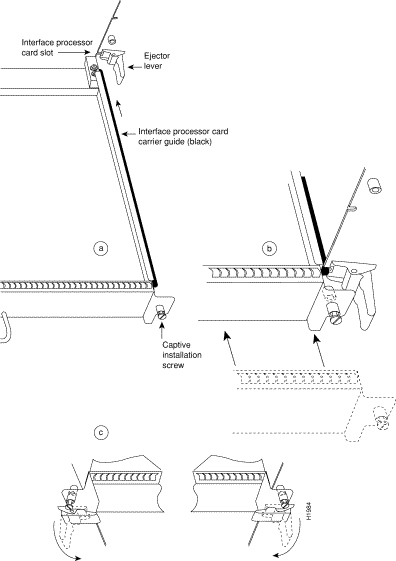
You need the following tools and parts to install or upgrade a POSIP. If you need additional equipment, contact your service representative for ordering information.
This section lists safety guidelines to follow when working with any equipment that connects to electrical power or telephone wiring.
Safety warnings appear throughout this publication in procedures that, if performed incorrectly, might harm you. A warning symbol precedes each warning statement.
Warning 
This warning symbol means danger. You are in a situation that could cause bodily injury. Before you work on any equipment, be aware of the hazards involved with electrical circuitry and be familiar with standard practices for preventing accidents. To see translations of the warnings that appear in this publication, refer to the Regulatory Compliance and Safety Information document that accompanied this device.
Waarschuwing Dit waarschuwingssymbool betekent gevaar. U verkeert in een situatie die lichamelijk letsel kan veroorzaken. Voordat u aan enige apparatuur gaat werken, dient u zich bewust te zijn van de bij elektrische schakelingen betrokken risico's en dient u op de hoogte te zijn van standaard maatregelen om ongelukken te voorkomen. Voor vertalingen van de waarschuwingen die in deze publicatie verschijnen, kunt u het document Regulatory Compliance and Safety Information (Informatie over naleving van veiligheids- en andere voorschriften) raadplegen dat bij dit toestel is ingesloten.
Varoitus Tämä varoitusmerkki merkitsee vaaraa. Olet tilanteessa, joka voi johtaa ruumiinvammaan. Ennen kuin työskentelet minkään laitteiston parissa, ota selvää sähkökytkentöihin liittyvistä vaaroista ja tavanomaisista onnettomuuksien ehkäisykeinoista. Tässä julkaisussa esiintyvien varoitusten käännökset löydät laitteen mukana olevasta Regulatory Compliance and Safety Information -kirjasesta (määräysten noudattaminen ja tietoa turvallisuudesta).
Attention Ce symbole d'avertissement indique un danger. Vous vous trouvez dans une situation pouvant causer des blessures ou des dommages corporels. Avant de travailler sur un équipement, soyez conscient des dangers posés par les circuits électriques et familiarisez-vous avec les procédures couramment utilisées pour éviter les accidents. Pour prendre connaissance des traductions d'avertissements figurant dans cette publication, consultez le document Regulatory Compliance and Safety Information (Conformité aux règlements et consignes de sécurité) qui accompagne cet appareil.
Warnung Dieses Warnsymbol bedeutet Gefahr. Sie befinden sich in einer Situation, die zu einer Körperverletzung führen könnte. Bevor Sie mit der Arbeit an irgendeinem Gerät beginnen, seien Sie sich der mit elektrischen Stromkreisen verbundenen Gefahren und der Standardpraktiken zur Vermeidung von Unfällen bewußt. Übersetzungen der in dieser Veröffentlichung enthaltenen Warnhinweise finden Sie im Dokument Regulatory Compliance and Safety Information (Informationen zu behördlichen Vorschriften und Sicherheit), das zusammen mit diesem Gerät geliefert wurde.
Avvertenza Questo simbolo di avvertenza indica un pericolo. La situazione potrebbe causare infortuni alle persone. Prima di lavorare su qualsiasi apparecchiatura, occorre conoscere i pericoli relativi ai circuiti elettrici ed essere al corrente delle pratiche standard per la prevenzione di incidenti. La traduzione delle avvertenze riportate in questa pubblicazione si trova nel documento Regulatory Compliance and Safety Information (Conformità alle norme e informazioni sulla sicurezza) che accompagna questo dispositivo.
Advarsel Dette varselsymbolet betyr fare. Du befinner deg i en situasjon som kan føre til personskade. Før du utfører arbeid på utstyr, må du vare oppmerksom på de faremomentene som elektriske kretser innebærer, samt gjøre deg kjent med vanlig praksis når det gjelder å unngå ulykker. Hvis du vil se oversettelser av de advarslene som finnes i denne publikasjonen, kan du se i dokumentet Regulatory Compliance and Safety Information (Overholdelse av forskrifter og sikkerhetsinformasjon) som ble levert med denne enheten.
Aviso Este símbolo de aviso indica perigo. Encontra-se numa situação que lhe poderá causar danos físicos. Antes de começar a trabalhar com qualquer equipamento, familiarize-se com os perigos relacionados com circuitos eléctricos, e com quaisquer práticas comuns que possam prevenir possíveis acidentes. Para ver as traduções dos avisos que constam desta publicação, consulte o documento Regulatory Compliance and Safety Information (Informação de Segurança e Disposições Reguladoras) que acompanha este dispositivo.
¡Advertencia! Este símbolo de aviso significa peligro. Existe riesgo para su integridad física. Antes de manipular cualquier equipo, considerar los riesgos que entraña la corriente eléctrica y familiarizarse con los procedimientos estándar de prevención de accidentes. Para ver una traducción de las advertencias que aparecen en esta publicación, consultar el documento titulado Regulatory Compliance and Safety Information (Información sobre seguridad y conformidad con las disposiciones reglamentarias) que se acompaña con este dispositivo.
Varning! Denna varningssymbol signalerar fara. Du befinner dig i en situation som kan leda till personskada. Innan du utför arbete på någon utrustning måste du vara medveten om farorna med elkretsar och känna till vanligt förfarande för att förebygga skador. Se förklaringar av de varningar som förkommer i denna publikation i dokumentet Regulatory Compliance and Safety Information (Efterrättelse av föreskrifter och säkerhetsinformation), vilket medföljer denna anordning.
The single-mode aperture port contains an laser warning label, as shown in Figure 6.

 | Warning Invisible laser radiation may be emitted from the aperture ports of the single-mode products when no fiber cable is connected. Avoid exposure and do not stare into open apertures. |
 | Warning Class 1 laser product. |
Follow these basic guidelines when working with any electrical equipment:
Use the following guidelines when working with any equipment that is connected to telephone wiring or to other network cabling:
Electrostatic discharge (ESD) damage, which can occur when electronic cards or components are improperly handled, results in complete or intermittent failures. The POSIP comprises a printed circuit board that is fixed in a metal carrier. Electromagnetic interference (EMI) shielding, connectors, and a handle are integral components of the carrier. Although the metal carrier helps to protect the board from ESD, always use a preventive antistatic strap when handling the POSIP. Handle the carriers by the handles and the carrier edges only; never touch the boards or connector pins.
 | Caution Always tighten the captive installation screws on the POSIP. (See Figure 5.) These screws prevent accidental removal, provide proper grounding for the system, and help ensure that the bus connectors are properly seated in the backplane. |
Following are guidelines for preventing ESD damage:
 | Caution For safety, periodically check the resistance value of the antistatic strap. The measurement should be between 1 and 10 megaohms. |
The Cisco 7000 series consists of the Cisco 7000 and Cisco 7010 routers. The POSIP will operate in the Cisco 7000 series routers providing these routers have the 7000 Series Route Switch Processor (RSP7000) and 7000 Series Chassis Interface (RSP7000CI) installed. For Cisco IOS software requirements, refer to the section "POSIP Software Requirements" on page 12. Network interfaces reside on modular interface processors, including the POSIP, which provide a direct connection between external networks and the high-speed CxBus in the Cisco 7000 series.
In the Cisco 7000, slot 5 is reserved for the RSP7000 (7000 RSP slot shown in Figure 7), which contains the system processor and performs packet switching functions, and slot 6 is reserved for the RSP7000CI (7000 CI slot shown in Figure 7), which contains all of the environmental monitoring functions for the Cisco 7000. The remaining five slots (slots 0 through 4) are for interface processors.
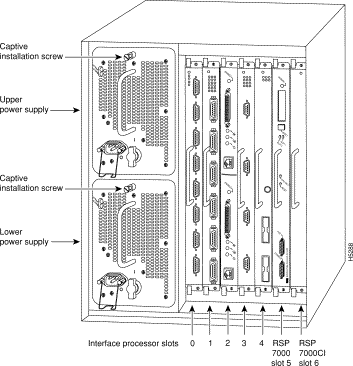
In the Cisco 7010, slot 3 is reserved for the RSP7000 (7000 RSP slot shown in Figure 8), which contains the system processor and performs packet switching functions, and slot 4 is reserved for the RSP7000CI (7000 CI slot shown in Figure 8), which contains all of the environmental monitoring functions for the Cisco 7010. The remaining three slots (slots 0 through 2) are for interface processors.
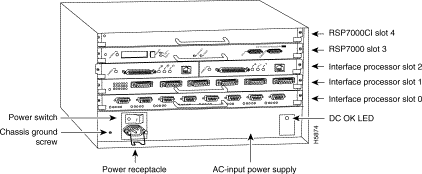
The Cisco 7500 series consists of the Cisco 7505, Cisco 7507, and Cisco 7513 routers. The POSIP will operate in all the Cisco 7500 series routers. For Cisco IOS software requirements, refer to the section "POSIP Software Requirements" on page 12. Network interfaces reside on modular interface processors, including the POSIP, which provide a direct connection between external networks and the high-speed CyBus in the Cisco 7500 series.
Figure 9, Figure 10, and Figure 11 show the rear of the Cisco 7500 series routers: the five-slot Cisco 7505, the seven-slot Cisco 7507, and the thirteen-slot Cisco 7513, respectively.
In the Cisco 7505 (see Figure 9), one slot (4) is reserved for the Route Switch Processor (RSP1), which contains the system processor and performs packet switching functions. Slots 0 through 3 are for interface processors.
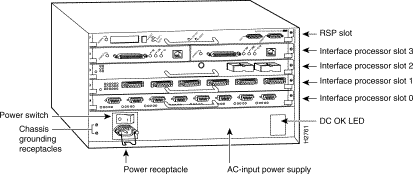
Figure 10 shows the rear of the seven-slot Cisco 7507 router. In the Cisco 7507, up to two slots (2 and 3) are reserved for the Route Switch Processor (RSP2), which contains the system processor and performs packet switching functions. Slots 0 and 1 and 4 through 6 are for interface processors.
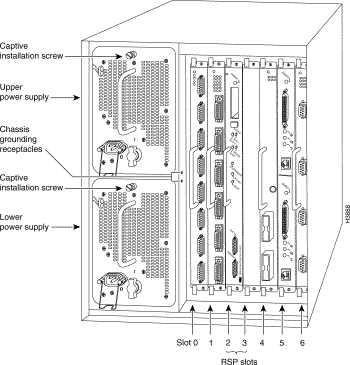
Figure 11 shows the rear of the Cisco 7513 with two AC-input power supplies installed. Two slots (6 and 7) are reserved for the Route Switch Processor (RSP2), which contains the system processor and performs packet switching functions. Slots 0 through 5 and 8 through 12 are for interface processors.
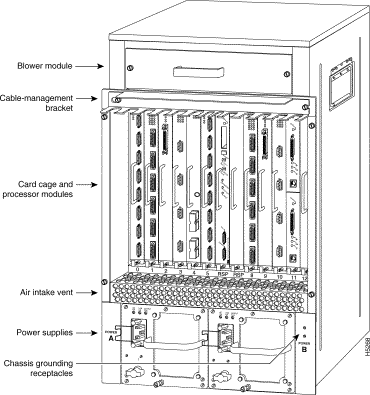
The following sections describe the procedures for removing or installing a POSIP in a Cisco 7000 series or 7500 series router. The online insertion and removal (OIR) feature allows you to install and remove a POSIP without turning off system power; however, you must follow the insertion instructions carefully. For example, failure to use the ejector levers or insert the POSIP properly can cause system error messages indicating a board failure.
The function of the ejector levers on the POSIP is to align and seat the card connectors in the backplane. Failure to use the ejectors and insert the interface processor properly can disrupt the order in which the pins make contact with the backplane. Follow the POSIP installation and removal instructions carefully, and review the following examples of incorrect insertion practices and results:
Use the ejector levers when removing a POSIP to ensure that the board connector pins disconnect from the backplane in the logical sequence expected by the system. Any RP, SP, or interface processor that is only partially connected to the backplane can hang the bus. Detailed steps for correctly performing OIR are included with the following procedures for installing and removing a POSIP.
 | Caution To avoid erroneous failure messages, remove or insert only one interface processor at a time. Also, after inserting or removing an interface processor, allow at least 15 seconds before removing or inserting another interface processor so that the system can reinitialize and note the current configuration of all interfaces. |
If you have a Cisco 7507 or a Cisco 7513 with an RSP2 configured as the system slave, we strongly recommend that you use the following procedure to remove and replace an interface processor:
Step 1 Remove the slave RSP2.
Step 2 Wait 15 seconds.
Step 3 Remove and replace the interface processor using the procedures in this publication.
Step 4 Wait 15 seconds.
Step 5 Reinsert the slave RSP2.
Before you remove an interface processor that you will not replace, or replace an interface processor component, we recommend you shut down (disable) the interfaces to prevent anomalies when you reinstall the new or reconfigured interface processor. When you shut down an interface, it is designated administratively down in the show command displays. Figure 12 shows proper handling of a POSIP during installation.
To remove a POSIP, follow these steps:
Step 1 Disconnect any interface cables from the ports on the front of the port adapter, although, this is not required. You can remove processor modules with cables attached; however, we do not recommend it.
Step 2 Slip on an ESD-preventive wrist strap and attach the strap to any unfinished surface on the chassis.
Step 3 Use a screwdriver to loosen the captive installation screws on the ends of the POSIP. (See Figure 12.)
 | Caution Always use the ejector levers to remove or install the POSIP. Failure to do so can cause erroneous system error messages indicating a board failure. |
Step 4 Place your thumbs on the upper and lower ejectors and simultaneously push the top ejector up and the bottom ejector down (in the opposite direction from that shown in Figure 5c) to release the POSIP from the backplane connector.
Step 5 Grasp the POSIP handle with one hand and place your other hand under the carrier to guide the POSIP out of the slot. (See Figure 12.) Avoid touching the board or any connector pins.
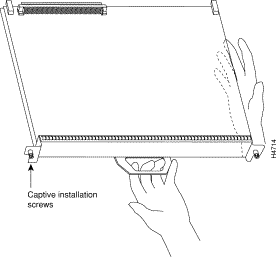
Step 6 Carefully pull the POSIP straight out of the slot, keeping your other hand under the carrier to guide the POSIP. (See Figure 12.) Keep the POSIP at a 90-degree orientation to the backplane.
Step 7 Place the removed POSIP on an antistatic mat or foam pad, or place the POSIP in an antistatic bag if returning the POSIP to the factory.
Step 8 If the interface processor slot is to remain empty, install an interface processor filler (MAS7K-BLANK) to keep dust out of the chassis and to maintain proper airflow through the interface processor compartment.
The POSIP slides into any available interface processor slot and connects directly to the backplane. The backplane slots are keyed so that the POSIP can be installed only in an interface processor slot. Interface processor fillers, which are blank interface processor carriers, occupy empty slots to maintain consistent airflow through the interface processor compartment.
If you are installing a new POSIP, you will have to first remove the interface processor filler from the available interface processor slot. Figure 5 shows the functional details of inserting an interface processor and using the ejectors. Figure 12 shows proper handling of an interface processor during installation.
 | Caution To avoid erroneous failure messages, remove or insert only one interface processor at a time. Also, after inserting or removing an interface processor, allow at least 15 seconds before removing or inserting another interface processor so that the system can reinitialize and note the current configuration of all interfaces. |
Follow these steps to install a new or replacement POSIP:
Step 1 Ensure that a console terminal is connected to the Console port on the RSP, and that the console terminal is turned on. (This step is optional.)
Step 2 Choose an available interface processor slot for the POSIP, and ensure that the interface cable is of a sufficient length to connect the POSIP with the network.
Step 3 Interface processors and interface processor fillers are secured with two captive installation screws. (See Figure 5.) Use a screwdriver to loosen the captive installation screws and remove the interface processor filler (or the existing POSIP) from the slot. If you remove a POSIP, immediately place it into an antistatic bag to prevent damage from electrostatic discharge.
Step 4 Hold the POSIP handle with one hand, and place your other hand under the carrier to support the POSIP and guide the carrier into the slot. (See Figure 12.) Avoid touching the card or any connector pins.
 | Caution To prevent ESD damage, handle interface processors by the handles and carrier edges only. |
Step 5 Place the back of the POSIP in the chassis slot and align the notch on the carrier with the groove in the slot. (See Figure 5a.)
Step 6 While keeping the POSIP at a 90-degree orientation to the backplane, carefully slide the POSIP into the slot until the back of the faceplate makes contact with the ejector levers, then stop. (See Figure 5b.)
Step 7 Using the thumb and forefinger of each hand to pinch each ejector, simultaneously push the levers inward (toward the handle) until they are at a full 90-degree orientation to the faceplate. (See Figure 5c.)
 | Caution To prevent system problems, always use the ejector levers when installing or removing processor modules. A module that is partially seated in the backplane will cause the system to hang and subsequently crash. |
Step 8 Use a 3/8-inch flat-blade screwdriver to tighten the captive installation screws on the ends of the POSIP. (See Figure 5.) (These screws must be tightened for maximum EMI protection.)
 | Caution To ensure that compliance with EMI standards is maintained, always tighten the captive installation screws on interface processors immediately after installation. Also, these screws prevent accidental removal and provide proper grounding for the system. |
Step 9 Attach either two simplex fiber cables or one duplex fiber cable between the Packet OC-3 interface port and your network. (See Figure 13 for the POSIP orientation applicable to your chassis type.) Ensure that you observe the receive (RX) and transmit (TX) cable relationship shown in Figure 13.
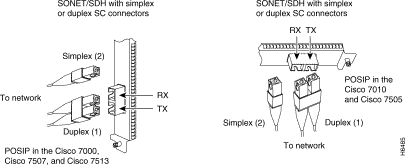
 | Warning Invisible laser radiation may be emitted from the aperture ports of the single-mode products when no fiber cable is connected. Avoid exposure and do not stare into open apertures. |
 | Warning Class 1 laser product. |
After you install the POSIP and connect optical-fiber cables, verify the installation by observing the LED states and the console display. When the system has reinitialized all interfaces, the enabled LED on the POSIP and on all interface processors should go on. The console screen will also display a message as the system discovers each interface during its reinitialization. After system initialization, the enabled LED, which is present on all interface processors, goes on to indicate that the POSIP is enabled for operation.
The following conditions must all be met before the POSIP is enabled; if any one of these conditions is not met, the enabled LED does not go on:
The three LEDs on POSIP's faceplate (see Figure 14) indicate the following:

When you remove and replace CxBus or CyBus interface processors, the system provides status messages on the console screen. The messages are for information only. The following sample display shows the events logged by the system as a POSIP was removed from slot 0; the system then reinitialized the remaining interface processors and marked as down the POSIP that was removed from slot 0. When the POSIP was reinserted, the system marked the interface as up again because the interface was not shut down before the POSIP was removed.
Router# %OIR-6-REMCARD: Card removed from slot 0, interfaces disabled %LINK-5-CHANGED: Interface POSIP0/0, changed state to administratively down Router# %OIR-6-INSCARD: Card inserted in slot 0, interfaces administratively shut down %LINK-5-CHANGED: Interface POSIP0/0, changed state to up
When a new POSIP is inserted or when a POSIP is moved to a new slot, the system recognizes the new interface, but leaves the interface in a down state until you configure the interface. Change the state to up with the configure command. The following example display shows the events logged by the system as a new POSIP is inserted in slot 3:
Router# %OIR-6-INSCARD: Card inserted in slot 3, interfaces administratively shut down
Verify that the POSIP is installed correctly as follows:
Step 1 While the system reinitializes each interface, observe the console display messages and verify that the system discovers the POSIP as follows:
Step 2 When the reinitialization is complete, verify that the enabled LED on the POSIP is on and remains on. If the LED does stay on, proceed to Step 5. If the enabled LED does not stay on, proceed to the next step.
Step 3 If the enabled LED on the POSIP fails to go on, suspect that the POSIP board connector is not fully seated in the backplane. Loosen the captive installation screws, then firmly push the top ejector down while pushing the bottom ejector up until both are at a 90-degree orientation to the POSIP faceplate. Tighten the captive installation screws. After the system reinitializes the interfaces, the enabled LED on the POSIP should go on. If the enabled LED goes on, proceed to Step 5. If the enabled LED does not go on, proceed to the next step.
Step 4 If the enabled LED still fails to go on, remove the POSIP and try installing it in another available interface processor slot.
Step 5 If the interface is new, proceed to "Configuring the POSIP" to configure the new interface. (The interface is not available until you configure it.)
Step 6 If this installation was a replacement POSIP, use the show interfaces or show controllers cbus command to verify the status of the interface. (Refer to the section "Checking the Installation" for command descriptions and examples.)
Step 7 When the interface is up, check the activity of the interface with the POSIP LEDs. (See Figure 1.) The LED states are described in the section "POSIP LEDs" on page 28.
If an error message displays on the console terminal, refer to the appropriate software publication for error message definitions. If you experience other problems that you are unable to solve, contact a service representative for assistance. This completes the POSIP installation. If you installed a new POSIP, you must now configure the new interface, as described in the following section.
To configure the POSIP, complete the following tasks.
On power up, a new POSIP is shut down. To enable the POSIP, you must enter the no shutdown command in the Configuration mode. (See the section "Using the configure Command," which follows.)
If you installed a new POSIP or want to change the configuration of an existing interface, you must enter Configuration mode. When the POSIP is enabled (taken out of shutdown) with no additional arguments, the default interface configuration file parameters are as listed in Table 7.
| Parameter | Configuration Commands | Default Value |
|---|---|---|
MTU | mtu bytes (no mtu bytes) | 4470 bytes |
Framing | posip framing-sdh (no posip framing-sdh) | SONET framing |
Loopback internal | loop internal (no loop internal) | No internal loopback |
Loopback line | loop line (no loop line) | No line loopback |
Transmit clocking | posip internal-clock | Loop timing |
SONET payload scrambling | pos scramble-atm | No scrambling |
With the loopback internal command, packets from the router are looped back in the framer. Outgoing data gets looped back to the receiver without actually being transmitted. With the loopback line command, the receive (RX) fiber is logically connected to the transmit fiber (TX) so that packets from the remote router are looped back to it. Incoming data is received by the received, gets looped around, and is retransmitted. For back-to-back operation, at least one of the POSIPs must be configured to supply its internal clock to the line.
After you verify that the new POSIP is installed correctly (the enabled LED goes on), you can use the configure command to configure the new interface. Be prepared with the information you will need, such as the interface IP address and MTU size.
Following are instructions for a basic configuration: enabling an interface and specifying IP routing. You might also need to enter other configuration subcommands, depending on the requirements for your system configuration and the protocols you plan to route on the interface. For complete descriptions of configuration subcommands and the configuration options available, refer to the appropriate software publications listed in the section "If You Need More Information" on page 2.
The Cisco 7000 series and 7500 series routers identify an interface address by its interface processor slot number and port number, in the format slot/port. Because each POSIP contains a single interface, the port number is always 0. For example, the slot/port address of an interface on a POSIP installed in interface processor slot 1 would be 1/0.
Before using the configure command, you must enter the privileged level of the EXEC command interpreter with the enable command. The system will prompt you for a password if one is set. Press the Return key after each configuration step unless otherwise noted.
The following steps describe a basic configuration.
Step 1 At the privileged-mode prompt, enter the Configuration mode and specify that the console terminal will be the source of the configuration subcommands as follows:
Router# configure terminal <CR>
Step 2 At the prompt, specify the new interface to configure by entering the interface command, followed by the type (posi) and slot/port (interface processor slot number/port number). The example that follows is for a POSIP in interface processor slot 1:
Router(config)# interface posi 1/0/0
Step 3 Determine the configure commands available for the POSIP's interface by entering posi ? at the Interface mode prompt, as follows:
Router(config-if)# posi ? posip framing-sdh select sdh framing internal-clock Use internal clock for transmit clock source transmitter-delay Set flag bytes to insert after transmitting a datagram
Use the preceding configuration commands according to your specific requirements and based on their functions as indicated and described in the section "POSIP Configuration Parameters," page 32, and in the appropriate software configuration publications.
Step 4 Determine the loopback commands available by entering loop ? at the Interface mode prompt, as follows:
Router(config-if)# loop ? internal internal line line
Use the preceding configuration commands according to your specific requirements and based on their functions as indicated and described in the section "POSIP Configuration Parameters," page 32, and in the appropriate software configuration publications.
Step 5 If IP routing is enabled on the system, you can assign an IP address and subnet mask to the interface with the ip address configuration subcommand, as in the following example:
Router(config-if)# ip address 10.1.2.3 255.255.255.0
Step 6 Change the shutdown state to up and enable the interface as follows:
Router(config-if)# no shutdown
The no shutdown command passes an enable command to the POSIP. It also causes the POSIP to configure itself based on the previous configuration commands sent.
Step 7 Add any additional configuration subcommands required to enable routing protocols and adjust the interface characteristics.
Step 8 When you have included all of the configuration subcommands to complete the configuration, enter ^Z (hold down the Control key while you press Z) to exit Configuration mode.
Step 9 Write the new configuration to memory as follows:
Router# copy running-config startup-config
The system will display an OK message when the configuration has been stored. For an explanation of show commands that allow you to check the interface configuration, see "Checking the Configuration."
The default values of all POSIP configuration parameters can be changed to match your network environment. Perform the tasks in the following sections if you need to customize the POSIP configuration:
The Packet OC-3 interface is referred to as posi in the configuration commands. An interface is created for each POSIP found in the system at reset time. To select a specific Packet OC-3 interface, use the interface posi slot/port adapter/interface command, as follows:
Router(config)# interface posi x/y/z
where x is the interface processor slot number and differs by the Cisco router in which the POSIP is installed, y is the port adapter slot (always 0), and z is the interface (always 0).
To set the transmission unit (MTU) size, use the following command:
Router(config-if)# mtu bytes Router(config-if)# no mtu
where bytes is in the range of 64 through 4470 bytes; and the default is 4470 bytes. (4470 bytes exactly matches FDDI and HSSI interfaces for autonomous switching.) The no form of the command restores the default.
The default framing setting is SONET STS-3c. To configure for SDH STM-1, use the following command:
Router(config-if)# posip framing-sdh
To change back to SONET STS-3c, use the no posip framing-sdh command.
To configure an interface for internal loopback, use the following commands:
Router(config-if)# loop internal Router(config-if)# no loop internal
Local loopback is useful for checking that the POSIP is working. Packets from router are looped back in the framer.
To configure an interface for line loopback, use the following commands:
Router(config-if)# loop line Router(config-if)# no loop line
The receive fiber (RX) is logically connected to the transmit fiber (TX) so that packets from the remote router are looped back to it. The incoming data is still received by the local interface.
By default, the POSIP uses the recovered receive clock to provide transmit clocking. To specify that the POSIP generates the transmit clock internally, use the following commands:
Router(config-if)# posip internal-clock Router(config-if)# no posip internal-clock
SONET payload scrambling applies a self-synchronous scrambler (x^43+1) to the Synchronous Payload Envelope (SPE) of the POS interface to ensure sufficient bit transition density.
To enable SONET payload scrambling on a POSIP, use the pos scramble-atm interface command. To disable SONET payload scrambling, use the no form of this command: no pos scramble-atm. This command has no keywords or arguments; the default is SONET payload scrambling disabled.
To determine whether SONET payload scrambling is enabled on a POS interface, use the show startup-config command; if enabled, the following line is displayed: pos scramble-atm.
(Also refer to the section "POSIP Installation Prerequisites," on page 11, for specific hardware and software requirements for using the SONET payload scrambling feature.)
The following example enables SONET payload scrambling on a POS interface:
Router(config)# interface pos 3/0/0 Router(config-if)# pos scramble-atm Router(config-if)# no shutdown Router(config-if)# end
The following example disables SONET payload scrambling on a POS interface:
Router(config)# interface pos 3/0/0 Router(config-if)# no pos scramble-atm Router(config-if)# end
The POSIP will maintain a count of certain errors. Each POSIP error counter is 32 bits. Errors include the following:
After configuring the new interface, use the show commands to display the status of the new interface or all interfaces.
Following are descriptions and examples of the show commands that display POSIP information.
Router# sh cont cbus
MEMD at 40000000, 2097152 bytes (unused 1888, recarves 3, lost 0)
RawQ 48000100, ReturnQ 48000108, EventQ 48000110
BufhdrQ 48000130 (2955 items), LovltrQ 48000148 (10 items, 1632 bytes)
IpcbufQ 48000150 (24 items, 4096 bytes)
3570 buffer headers (48002000 - 4800FF10)
pool0: 16 buffers, 256 bytes, queue 48000138
pool1: 229 buffers, 1536 bytes, queue 48000140
pool2: 332 buffers, 4480 bytes, queue 48000158
pool3: 4 buffers, 4512 bytes, queue 48000160
(additional displayed text omitted)
slot2: VIP2, hw 2.3, sw 21.44, ccb 5800FF40, cmdq 48000090, vps 8192
software loaded from flash slot1:muck/biff/vip2_21-44
FLASH ROM version 255.255
POS2/0/0, applique is SONET
gfreeq 48000158, lfreeq 48000168 (4480 bytes), throttled 0
rxlo 4, rxhi 332, rxcurr 0, maxrxcurr 0
txq 48001A00, txacc 48001A02 (value 221), txlimit 221
Router# sh int pos 2/0/0 POS2/0/0 is up, line protocol is up Hardware is cyBus Packet over Sonet Internet address is 1.1.1.1/27 MTU 4470 bytes, BW 155000 Kbit, DLY 100 usec, rely 255/255, load 1/255 Encapsulation HDLC, loopback not set, keepalive not set Last input 2d20h, output never, output hang never Last clearing of "show interface" counters 2d00h Queueing strategy: fifo Output queue 0/40, 0 drops; input queue 0/75, 0 drops 5 minute input rate 0 bits/sec, 0 packets/sec 5 minute output rate 0 bits/sec, 0 packets/sec 3600000 packets input, 1119432704 bytes, 0 no buffer Received 0 broadcasts, 0 runts, 0 giants, 0 parity 0 input errors, 0 CRC, 0 frame, 0 overrun, 0 ignored, 0 abort 0 packets output, 0 bytes, 0 underruns 0 output errors, 0 applique, 0 interface resets 0 output buffer failures, 0 output buffers swapped out 0 carrier transitions
Router# sh diag 2
Slot 2:
Physical slot 2, ~physical slot 0xD, logical slot 2, CBus 0
Microcode Status 0x4
Master Enable, LED, WCS Loaded
Board is analyzed
Pending I/O Status: None
EEPROM format version 1
VIP2 controller, HW rev 2.4, board revision B0
Serial number: 03514213 Part number: 73-1684-03
Test history: 0x00 RMA number: 00-00-00
Flags: cisco 7000 board; 7500 compatible
EEPROM contents (hex):
0x20: 01 15 02 03 00 35 9F 65 49 06 94 03 00 00 00 00
0x30: 06 3C 00 2A 1A 00 00 00 00 00 00 00 00 00 00 00
Slot database information:
Flags: 0x4 Insertion time: 0x1294 (00:13:39 ago)
Controller Memory Size: 32 MBytes DRAM, 1024 KBytes SRAM
PA Bay 0 Information:
POS PA, 1 port
EEPROM format version 1
HW rev 1.5, Board revision A0
Serial number: 00000032 Part number: 73-1803-04
Router# sh version Cisco Internetwork Operating System Software IOS (tm) GS Software (RSP-JV-M), Released Version 11.1(8)CA [biff 100] Copyright (c) 1986-1996 by cisco Systems, Inc. Compiled Fri 10-May-96 06:48 by biff Image text-base: 0x600108A0, data-base: 0x60936000 ROM: System Bootstrap, Version 5.3(16645) [biff 571], INTERIM SOFTWARE ROM: GS Bootstrap Software (RSP-BOOT-M), Version 11.1(8)CA, RELEASE SOFTWARE (fc2) Router uptime is 2 minutes System restarted by power-on System image file is "dirt/biff/rsp-jv-mz", booted via tftp from 1.1.1.253 cisco RSP2 (R4600) processor with 16384K bytes of memory. R4600 processor, Implementation 32, Revision 2.0 Last reset from power-on G.703/E1 software, Version 1.0. SuperLAT software copyright 1990 by Meridian Technology Corp). Bridging software. X.25 software, Version 2.0, NET2, BFE and GOSIP compliant. TN3270 Emulation software (copyright 1994 by TGV Inc). 1 POSIP controller (1 POSI). 1 Packet over Sonet network interface. 125K bytes of non-volatile configuration memory. 8192K bytes of Flash PCMCIA card at slot 0 (Sector size 128K). 8192K bytes of Flash internal SIMM (Sector size 256K). No slave installed in slot 7. Configuration register is 0x0 (display text omitted)
Router# sh running-config interface posip2/0/0 ip address 1.1.1.3 255.255.255.0 ip route-cache distributed no keepalive clock source internal pos scramble-atm crc 16
The only error message you should see would be of the following type and format:
%POSIP-0-MSG: %DEBUGGER-0-STACK_DATA8: 00E0 FFFFFFFF 80057F50 00000000 00000000 FFFFFFFF 80032CD4 00000000 00000000
You define Cisco 7000 series and 7500 series interfaces by interface type and physical slot/port location. The output of the show interfaces command displays the logical unit number in the router and the physical slot/port location in the Cisco 7000 series and 7500 series routers. To connect two routers, attach the cable between the Packet OC-3 port on each one. By default, the POSIP uses loop timing mode. To specify that the POSIP generates the transmit clock internally, add the posip internal-clock command to your configuration.
Following is an example of configuration file commands for two routers (each with a POSIP in slot 3) connected back to back through their Packet OC-3 interfaces:
First router:
interface POS3/0/0 ip address 1.1.1.1 255.0.0.0 no keepalive posip internal-clock
Second router
interface POS3/0/0 ip address 1.1.1.2 255.0.0.0 no keepalive
The following procedures describe the steps required to upgrade the two DRAM single in-line memory modules (SIMMs) and the one SRAM dual in-line memory module (DIMM) on the POSIP, or to replace the DRAM or SRAM if a system problem has indicated their replacement. Depending on your system configuration and the Cisco IOS your system is running, you might need to upgrade DRAM and SRAM. Following is the available POSIP upgrade product: MEM-POSIP-64MB(=)
The following sections describe upgrading DRAM and SRAM:
The DRAM on the POSIP is contained in two SIMMs located in sockets U2 and U6. (See Figure 15.) Depending on your system configuration, a memory upgrade might be required. Also, if a system problem is determined to be caused by a SIMM, a SIMM replacement might be required. Use the following procedures to replace the DRAM SIMMs on your POSIP.
 | Caution To prevent ESD damage, handle SIMMs by the card edges only. (See Figure 17 on page 41.) Place removed SIMMs on an antistatic mat and store them in an antistatic container. |
Follow these steps to remove the existing SIMMs:
Step 1 Turn OFF the system power and follow the steps in the section "Removing the POSIP" on page 25.
Step 2 Place the POSIP on an antistatic mat or pad and ensure that you are wearing an antistatic device, such as a wrist strap. Position the POSIP so that the handle is away from you and the bus connector is toward you—opposite of the position shown in Figure 15.
Step 3 Locate the SIMMs. The DRAM SIMMs occupy sockets U2 and U6. (See Figure 15.)

Step 4 Release the spring clips from the SIMM that you want to remove and release the SIMM from the socket. (See Figure 16.)
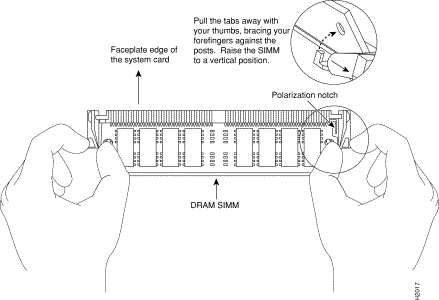
Step 5 When both ends of the SIMM are released from the socket, grasp the ends of the SIMM with your thumb and forefinger and pull the SIMM completely out of the socket. Handle the edges of the SIMM only; avoid touching the memory module or pins, and the metal traces, or fingers, along the socket edge.
Step 6 Place the SIMM in an antistatic container to protect it from ESD damage.
Step 7 Repeat Steps 4 through 6 for the remaining SIMM, as required for this replacement.
This completes the SIMM removal procedure. Proceed to the next section to install the new SIMMs.
SIMMs are sensitive components that are susceptible to ESD damage. Handle SIMMs by the edges only; avoid touching the memory modules, pins, or traces (the metal fingers along the connector edge of the SIMM). (See Figure 17.)
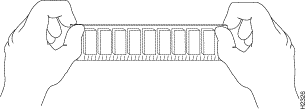
 | Caution To prevent ESD damage, handle SIMMs as shown in Figure 17. |
Follow these steps to install the new SIMMs:
Step 1 With the POSIP in the same orientation as the previous procedure (with the handle away from you and the bus connector toward you), you are going to install the first SIMM in the socket farthest from you. Then you will install the last SIMM in the socket closest to you.
Step 2 Remove a new SIMM from the antistatic container.
Step 3 Hold the SIMM component side up, with the connector edge (the metal fingers) closest to you.
Step 4 Hold the sides of the SIMM between your thumb and middle finger, with your forefinger against the far edge, opposite the connector edge. (See Figure 17.)
Step 5 Tilt the SIMM to approximately the same an angle as the socket and insert the connector edge into the socket.
 | Caution When inserting SIMMs, use firm but not excessive pressure. If you damage a socket, you will have to return the POSIP to the factory for repair. |
Step 6 Gently push the SIMM into the socket until the spring clips snap over the ends of the SIMM. If necessary, rock the SIMM gently back and forth to seat it properly.
Step 7 Repeat Steps 2 through 6 for the remaining SIMM.
Step 8 When both SIMMs are installed, check all four alignment holes (two on each SIMM) and ensure that the spring retainer is visible. If it is not, the SIMM is not seated properly. If any SIMM appears misaligned, carefully remove it and reseat it in the socket. Push the SIMM firmly back into the socket until the retainer springs snap into place.
This completes the SIMM replacement procedure. Proceed to the section "Replacing the POSIP SRAM DIMM."
The SRAM on the POSIP is contained in a DIMM and located in socket U5. (See Figure 15 on page 39.) Depending on your system configuration, a memory upgrade might be required. Also, if a system problem is determined to be caused by the DIMM, a DIMM replacement might be required. Use the following procedures to replace the SRAM DIMM on your POSIP.
 | Caution To prevent ESD damage, handle the DIMM by the edges only. Place a removed DIMM on an antistatic mat and store it in an antistatic container. |
Follow these steps to remove the existing DIMM:
Step 1 Turn OFF the system power and follow the steps in the section "Removing the POSIP" on page 25, if required.
Step 2 Place the POSIP on an antistatic mat or pad, and ensure that you are wearing an antistatic device, such as a wrist strap. Position the POSIP so that the handle is toward you and the bus connector is facing away from you, approximately as shown in Figure 15.
Step 3 Locate the DIMM. The SRAM DIMM occupies socket U5. (See Figure 15.)
Step 4 Locate the release lever on the DIMM socket (see circle in Figure 18) and release the DIMM from the socket as shown.
Step 5 When one end of the DIMM is released from the socket (see Figure 18), grasp the ends of the DIMM with your thumb and forefinger and pull the DIMM completely out of the socket. Handle the edges of the DIMM only. (See Figure 19.)

Step 6 Place the DIMM in an antistatic container to protect it from ESD damage.
This completes the DIMM removal procedure. Proceed to the next section to install the new DIMM.
The DIMM is sensitive component that is susceptible to ESD damage. Handle the DIMM by the edges only; avoid touching the memory modules, pins, or traces (the metal fingers along the connector edge of the DIMM). (See Figure 19.)
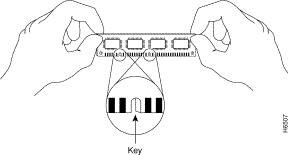
 | Caution To prevent ESD damage, handle the DIMM as shown in Figure 19. |
Follow these steps to install the new DIMM:
Step 1 With the POSIP in the same orientation as the previous procedure (with the handle toward you and the bus connector away from you), you will install the DIMM in socket U5.
Step 2 Remove the new DIMM from the antistatic container.
Step 3 Hold the DIMM component side up, with the connector edge (the metal fingers) down. (See Figure 19.) Hold the sides of the DIMM between your thumb and fore finger.
Step 4 Tilt the DIMM to approximately the same an angle as the socket and insert the connector edge into the socket. Note the two notches (keys) on the connector edge of the DIMM. (See Figure 19.) These keys are intended to assure correct orientation of the DIMM in the socket.
 | Caution When inserting the DIMM, use firm but not excessive pressure. If you damage a socket, you will have to return the POSIP to the factory for repair. |
Step 5 Note the orientation of the socket key on the SRAM DIMM and the DIMM socket and gently push the DIMM into the socket until the release lever is flush against the side of the DIMM socket (see Figure 20) and the DIMM's edge connector is fully inserted. If necessary, rock the DIMM gently back and forth to seat it properly.

Step 6 When the DIMM is installed, check that the release lever is flush against the side of the DIMM socket. (See Figure 20.) If it is not, the DIMM might not be seated properly. If the DIMM appears misaligned, carefully remove it according to the removal procedure, and reseat it in the socket. Push the DIMM firmly back into the socket until release lever is flush against the side of the DIMM socket.
This completes the DIMM replacement procedure.
To replace the POSIP in your system, refer to the section "Installing a New or Replacement POSIP and Connecting Interface Cables" on page 26.
If, after a DRAM or SRAM replacement, the system fails to boot properly, or if the console terminal displays a checksum or memory error, check the following:
Refer to the section "Checking the Installation," on page 28, as required. If after several attempts the system fails to restart properly, contact a service representative for assistance. Before you call, make note of any error messages, unusual LED states, or any other indications that might help solve the problem.
Cisco Connection Online (CCO) is Cisco Systems' primary, real-time support channel. Maintenance customers and partners can self-register on CCO to obtain additional information and services.
Available 24 hours a day, 7 days a week, CCO provides a wealth of standard and value-added services to Cisco's customers and business partners. CCO services include product information, product documentation, software updates, release notes, technical tips, the Bug Navigator, configuration notes, brochures, descriptions of service offerings, and download access to public and authorized files.
CCO serves a wide variety of users through two interfaces that are updated and enhanced simultaneously: a character-based version and a multimedia version that resides on the World Wide Web (WWW). The character-based CCO supports Zmodem, Kermit, Xmodem, FTP, and Internet e-mail, and it is excellent for quick access to information over lower bandwidths. The WWW version of CCO provides richly formatted documents with photographs, figures, graphics, and video, as well as hyperlinks to related information.
You can access CCO in the following ways:
For a copy of CCO's Frequently Asked Questions (FAQ), contact cco-help@cisco.com. For additional information, contact cco-team@cisco.com.

![]()
![]()
![]()
![]()
![]()
![]()
![]()
![]()
Posted: Tue Oct 15 08:04:50 PDT 2002
All contents are Copyright © 1992--2002 Cisco Systems, Inc. All rights reserved.
Important Notices and Privacy Statement.